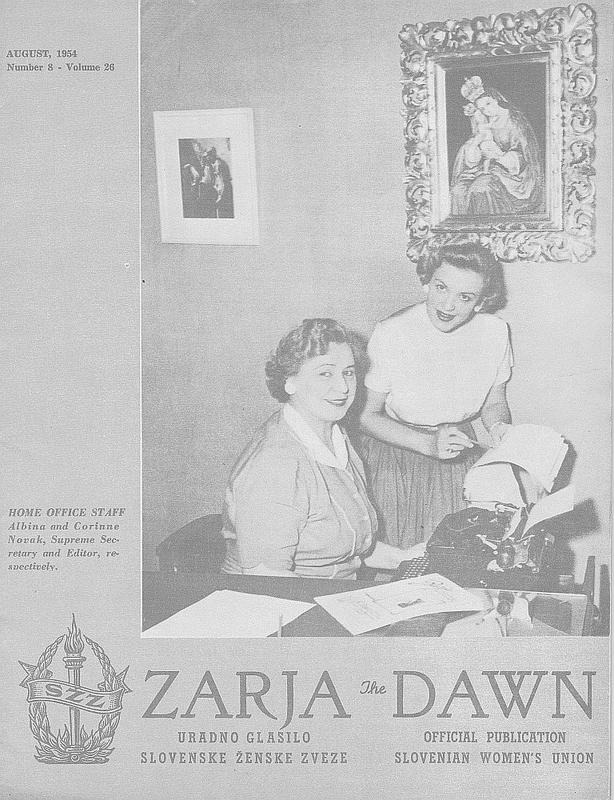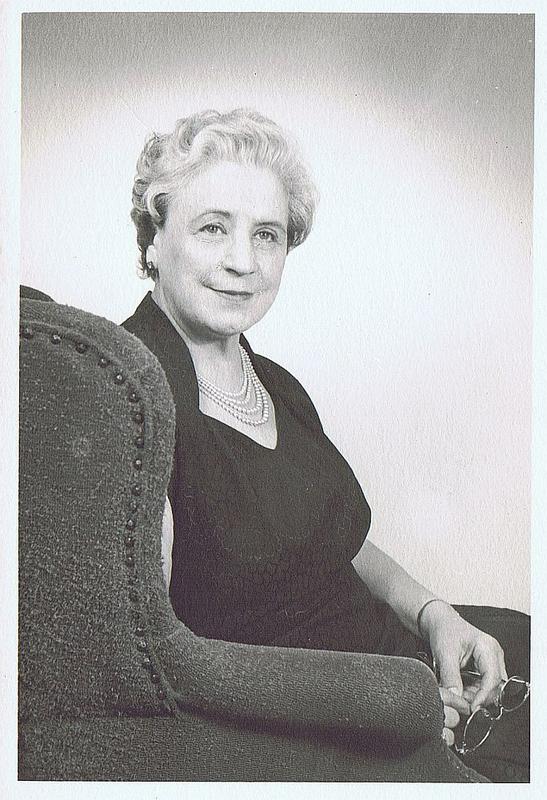
Editors of Zarja: Julia Gottlieb (1929–1930), Josephine Racic (1930–1933), Albina Novak (1933–1952), Corinne Leskovar (1952–2006), Debbie Pohar (2006–).
Zarja is a magazine written by the Slovenian Americans. It was first published 85 years ago. Its first editor was Julia Gottlieb. The current editor of the magazine is Debbie Pohar.

At that time, the world of immigration was different than it is now. Slovenians who immigrated had to accept the hardest jobs. They were living in harmony with nature, they were modest and happy, and fulfilled as human beings, even though they sacrificed and gave up many things to start a better life in America.
They are a true inspiration to everyone holding Zarja's pen today. Even though this pen only writes English words, the words reflect a Slovenian melody. We hope that this pen would soon write Slovenian words again and not only reflect a Slovenian melody.
Zarja is a magazine written by the Slovenian Americans. It was first published 85 years ago. Its first editor was Julia Gottlieb. The creators of the magazine celebrated this high anniversary in the National and University Library in Ljubljana. The current editor of the magazine is Debbie Pohar. The magazine is her hobby and not a job. But just like her predecessors, she takes her job seriously. What matters the most is that she is not alone. Just like her predecessors, she is surrounded by a team which she can rely on. A 85-year-old Corrine Leskovar also joined the creators of the magazine at the celebration in Ljubljana. She was the editor of Zarja from 1952 to 2006 when Debbie Pohar took over her work.
Zarja was first published in 1929
The women who joined Marie Prisland decided that they will publish an informative and interesting magazine which will provide help to women who had moved to this foreign country. The first issues of Zarja were written only in Slovenian. Later on, the issues already included some articles in English at the end of the magazine. Following a change in 1956, Zarja had eight pages in Slovenian and eight pages in English. Zarja published articles on everyday life, health, family, education, cooking, understanding of the American culture and religion. The writers also wrote about very personal experience. Zarja was an educational tool for everyone who had moved to America. The magazine helped people to easily and quickly understand the American society. Slovenians wanted to become true American citizens as soon as possible, but at the same time they wanted to retain their Slovenian identity. Unfortunately, their descendants no longer speak Slovenian or they speak it very poorly, but the children of the first immigrants want to return to their roots. Unfortunately, Zarja is no longer written in Slovenian. The pen is only writing English words.
Today, the magazine is not published by the Slovenian Women's Union. As men and children also wanted to feel closer to their homeland, the union was renamed the Slovenian Union of America (SUA). It preserves the Slovenian culture in America though different activities. Its members like to socialize. Many friendships are formed. All Slovenians and friends of Slovenia are always welcome among them. Zarja is 85 years old but it kept its freshness and youth. The same goes for Corinne Leskovar. She has a sparkle in her eyes. Where does this glow come from?
Corinne Leskovar
Corinne Leskovar begins the story with her mother who was the editor of the magazine before her. In her opinion, Albina Novak was a great women, full of talents. She was very busy with her large family and active in the parish and the community. She was surrounded by Slovenians and was brought up to love her family and the broader community. Therefore, it is no surprise that she was working for the community with all her heart.
Corinne says: "At that time, the world of immigration was different than it is now. Slovenians who immigrated had to accept the hardest jobs. They were living in harmony with nature, they were modest and happy, and fulfilled as human beings, even though they sacrificed and gave up many things to start a better life in America. They were brave and sensitive, and they regarded the community as an important value." They were living in different parts of America. The majority were situated in Cleveland where they found jobs and set up a family life. They were very closely connected. One of them was Marie Prisland who especially cherished this friendship. To connect the community she wrote letters and she was quickly followed by a number of other women and girls. At the beginning, an issue of Zarja cost only 25 cents, a small sum that these women could easily afford. They sent the money by mail or gave it to volunteers who collected it door-to-door. "One of them was also Mary Otoničar who collected the contributions personally. Thanks to her, 1500 new members joined the Union. The other person who responded to this call and was very successful in this was my mother," says Corinne.
Slovenian gossip girls
Even though they were living in different parts of America, the distance did not stop them to attend the meetings organised by the Union. Corinne remembers that her mother made her very pretty for that occasion. "I had to look pretty, it was a holiday," she said. They met in the parish, at home or in halls of a community house when they came in large numbers. These meetings were very long as the ladies had many things to say. They spoke Slovenian. They were happy to meet as they respected the sense of belonging.
It was a mission, not a career
Corinne's childhood was all about the Women's union and Zarja. Her mother had been the editor for 19 years. When Corinne came home from school, the family room was often covered in papers: articles for Zarja, cuttings from other newspapers, cultural programmes, invitations etc. Zarja was typed manually at that time. Corinne was of great help to her mother. They spent hours on editing articles, writing addresses on the envelopes and updating the list of addresses. The first printing house that printed Zarja was American Publishing Co. from Cleveland. When Corinne was in high school, her mother owned a small office on the second floor of a building where many Slovenian newspapers and other publications were printed for the Slovenian community. "At that time, boys were delivering the newspaper. We also sent it by train. Many of those boys grew up and became important and successful men in the field of economy, politics and society," said Corinne. In 1952, her mother became the president of the Union. A question who will replace her as editor was raised and Corinne was the obvious choice as she was her mother's intern during all her childhood. She remained the editor even when she moved to Chicago with her husband, who was a Slovenian, as she likes to point out.
The love of giving remains
Corinne praises the new editor. "Debbie is working very hard. We have a great magazine." Her love of Zarja is still alive even if she is no longer writing for it. She says: "I cannot get rid of the feeling that I must not throw away any piece of information, article, newspaper, magazine, programme or contact as I never know when it might come in handy when writing a certain issue of the magazine." Corinne knows practically all the Slovenian communities in America and has many friends. Even during the meeting in Ljubljana, she did not sit alone. She spoke highly of her mother and all brave women who fought for a better life: "These women were brilliant article writers and photographers. Many of them did a lot for the Slovenian community in America. They were volunteers who worked for Zarja with love and supported each other. This is also my legacy. I want Debbie and the girls to work together for the community with love and carry their homeland in their hearts."
Tanja Glogovčan, SINFO
Editors of Zarja: Julia Gottlieb (1929–1930), Josephine Racic (1930–1933), Albina Novak (1933–1952), Corinne Leskovar (1952–2006), Debbie Pohar (2006–).
Zarja is a magazine written by the Slovenian Americans. It was first published 85 years ago. Its first editor was Julia Gottlieb. The current editor of the magazine is Debbie Pohar.
At that time, the world of immigration was different than it is now. Slovenians who immigrated had to accept the hardest jobs. They were living in harmony with nature, they were modest and happy, and fulfilled as human beings, even though they sacrificed and gave up many things to start a better life in America.

































































